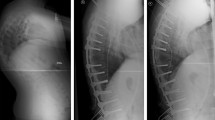Abstract
Purpose
The purpose was to study intraoperative spinal cord monitoring (IOM) particularities and performances in children under 4 years old with congenital spinal deformities. IOM is characterized by specific difficulties due to the immaturity of sensory-motor pathways in such young patients. To the best of our knowledge, this study is the largest dedicated to IOM in this challenging population.
Methods
This study was retrospective and monocentric. 78 IOM in children under 4 years old were analyzed. Somatosensory evoked potentials (SSEP), neurogenic mixed evoked potentials (NMEP) and D waves were performed. Patients were classified into one of four categories with respect to IOM data and clinical outcome: true positive, false positive, true negative and false negative. Sensitivity and specificity were then calculated accordingly.
Results
There were 6 true positive, 3 false positive, 67 true negative and 1 false negative outcomes. One patient was characterized by unreliable baseline IOM data. IOM sensitivity was 86 %. IOM specificity was 96 %. The false negative case was monitored using SSEP alone. IOM was difficult in 10/77 cases, being unilateral because of a planned fibular graft harvest. NMEP were characterized by higher signal-to-noise ratio than SSEP.
Conclusions
Immaturity of sensory-motor pathways predominates in the central rather than the peripheral nervous system in young children. MEP and D waves could thus be difficult to obtain. Although non-specific to motor pathways, it could be useful to “by-pass” the brain, using NMEP. In regard to maturational particularities, IOM in children under 4 years old should be performed by experienced neurophysiologists, avoiding in these cases surgeon-guided devices.




Similar content being viewed by others
Abbreviations
- IOM:
-
Intraoperative spinal cord monitoring
- MEP:
-
Motor evoked potentials
- NMEP:
-
Neurogenic mixed evoked potentials
- SSEP:
-
Somatosensory evoked potentials
References
Helmers SL, Hall JE (1994) Intraoperative somatosensory evoked potential monitoring in pediatrics. J Pediatr Orthop 14:592–598
Cheh G, Lenke LG, Padberg AM, Kim YJ, Daubs MD, Kuhns C, Stobbs G, Hensley M (2008) Loss of spinal cord monitoring signals in children during thoracic kyphosis correction with spinal osteotomy: why does it occur and what should you do? Spine (Phila Pa 1976) 33:1093–1099. doi:10.1097/BRS.0b013e31816f5f73
Bollini G, Docquier PL, Viehweger E, Launay F, Jouve JL (2006) Thoracolumbar hemivertebrae resection by double approach in a single procedure: long-term follow-up. Spine (Phila Pa 1976) 31:1745–1757. doi:10.1097/01.brs.0000224176.40457.52
Sala F, Krzan MJ, Deletis V (2002) Intraoperative neurophysiological monitoring in pediatric neurosurgery: why, when, how? Childs Nerv Syst 18:264–287. doi:10.1007/s00381-002-0582-3
Gavaret M, Trébuchon A, Aubert S, Jacopin S, Blondel B, Glard Y, Jouve JL, Bollini G (2011) Intraoperative monitoring in pediatric orthopedic spinal surgery: three hundred consecutive monitoring cases of which 10% of patients were younger than 4 years of age. Spine (Phila Pa 1976) 36:1855–1863. doi:10.1097/BRS.0b013e3181f806d9
Péréon Y, Bernard JM, Fayet G, Delécrin J, Passuti N, Guihéneuc P (1998) Usefulness of neurogenic motor evoked potentials for spinal cord monitoring: findings in 112 consecutive patients undergoing surgery for spinal deformity. Electroencephalogr Clin Neurophysiol 108:17–23
Gavaret M, Jouve JL, Péréon Y, Accadbled F, André-Obadia N, Azabou E, Blondel B, Bollini G, Delécrin J, Farcy JP, Fournet-Fayard J, Garin C, Henry P, Manel V, Mutschler V, Perrin G, Sales de Gauzy J, SFCR FSoSS (2013) Intraoperative neurophysiologic monitoring in spine surgery. Developments and state of the art in France in 2011. Orthop Traumatol Surg Res 99:S319–S327. doi:10.1016/j.otsr.2013.07.005
Szalay EA, Carollo JJ, Roach JW (1986) Sensitivity of spinal cord monitoring to intraoperative events. J Pediatr Orthop 6:437–441
Lieberman JA, Lyon R, Feiner J, Diab M, Gregory GA (2006) The effect of age on motor evoked potentials in children under propofol/isoflurane anesthesia. Anesth Analg 103:316–321. doi:10.1213/01.ane.0000226142.15746.b2 (table of contents)
Szelényi A, Bueno de Camargo A, Deletis V (2003) Neurophysiological evaluation of the corticospinal tract by D-wave recordings in young children. Childs Nerv Syst 19:30–34. doi:10.1007/s00381-002-0691-z
Müller K, Hömberg V, Lenard HG (1991) Magnetic stimulation of motor cortex and nerve roots in children. Maturation of cortico-motoneuronal projections. Electroencephalogr Clin Neurophysiol 81:63–70
Frei FJ, Ryhult SE, Duitmann E, Hasler CC, Luetschg J, Erb TO (2007) Intraoperative monitoring of motor-evoked potentials in children undergoing spinal surgery. Spine (Phila Pa 1976) 32:911–917. doi:10.1097/01.brs.0000259836.84151.75
Drake J, Zeller R, Kulkarni AV, Strantzas S, Holmes L (2010) Intraoperative neurophysiological monitoring during complex spinal deformity cases in pediatric patients: methodology, utility, prognostication, and outcome. Childs Nerv Syst 26:523–544. doi:10.1007/s00381-010-1115-0
Koh TH, Eyre JA (1988) Maturation of corticospinal tracts assessed by electromagnetic stimulation of the motor cortex. Arch Dis Child 63:1347–1352
Nezu A, Kimura S, Uehara S, Kobayashi T, Tanaka M, Saito K (1997) Magnetic stimulation of motor cortex in children: maturity of corticospinal pathway and problem of clinical application. Brain Dev 19:176–180 (S0387760496005529 [pii])
Minahan RE, Sepkuty JP, Lesser RP, Sponseller PD, Kostuik JP (2001) Anterior spinal cord injury with preserved neurogenic ‘motor’ evoked potentials. Clin Neurophysiol 112:1442–1450 (S1388245701005673 [pii])
Polirsztok E, Gavaret M, Gsell T, Suprano I, Choufani E, Bollini G, Jouve JL (2015) Sublaminar bands: are they safe? Eur Spine J 24:1441–1449. doi:10.1007/s00586-014-3594-2
Eccher M (2012) Intraoperative neurophysiologic monitoring: are we really that bad? J Clin Neurophysiol 29:157–159. doi:10.1097/WNP.0b013e31824ff6d0
Acknowledgments
The authors thank Dr. Aileen McGonigal for the revision of the English version.
Author information
Authors and Affiliations
Corresponding author
Ethics declarations
Conflict of interest
None.
Rights and permissions
About this article
Cite this article
Gavaret, M., Pesenti, S., Choufani, E. et al. Intraoperative spinal cord monitoring in children under 4 years old. Eur Spine J 25, 1847–1854 (2016). https://doi.org/10.1007/s00586-016-4553-x
Received:
Revised:
Accepted:
Published:
Issue Date:
DOI: https://doi.org/10.1007/s00586-016-4553-x




